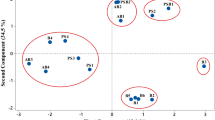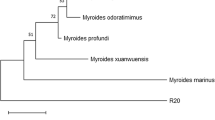Abstract
Plant growth-promoting rhizobacteria (PGPR) are beneficial microorganisms to develop microbial fertilizers. Biofertilizers can accelerate plant growth and enhance crop yields. The current research aimed to isolate and identify rhizobacterium with plant growth-promoting activity in the rhizospheric region of pistachio trees in arid and salty region of Iran. In the present study, 26 bacterial isolates were isolated from the rhizospheric region of the pistachio trees. Plant growth-promoting characteristics of isolated bacteria, including the ability to solubilize phosphate and zinc, produce hydrolyzing enzymes, and hydrogen cyanide (HCN), as well as synthesize indole-3-acetic acid (IAA) were evaluated through in vitro assays. Based on these activities, five multifunctional bacterial strains designated P1, P10, P11, P17, and P19 were then applied and their effect was studied on the growth and physiological properties of Pistacia vera L. seedlings by pot experiments under normal conditions. Finally, the most efficient strain has been identified by analysis of the 16S rRNA gene sequence. According to the results, all the isolated bacteria exhibited considerable plant growth-promoting properties. They could produce amylase (n = 26, 2 ± 0.00–13 ± 0.42 mm), lipase (n = 24, 2 ± 0.00–9 ± 0.23 mm), protease (n = 20, 1 ± 0.00–17 ± 0.0 mm), indole-3-acetic acid (n = 26, ranging from 5.05 ± 0.08 to 11.5 ± 0.11 μg/mL) and HCN (n = 24). Six isolates showed significant growth at 20% w/v NaCl. Inoculation of P1, P17, and P19 increased chlorophyll, carotenoid, and phenolic content in treated Pistacia vera L. seedlings. P1 and P11 inoculated plants showed an enhanced level of anthocyanin and proline. These most effective strains were catalase and Gram-positive bacterium and showed antibiotic sensitivity. They can consider as halotolerant PGPR, due to the growth in the presence of NaCl (20% w/v). Finally, P1 inoculated plants exhibited higher levels of sugar content. This strain showed the most similarity (99.92%–1322 bp) to Paenarthrobacter nitroguajacolicus based on 16S rRNA gene sequence. Based on the results, Paenarthrobacter nitroguajacolicus P1 with multiple PGPR can be applied as a promising candidate in the soil-Pistacia vera L. system to improve their productivity and health by increasing available nutrient content, improving photosynthetic parameters, and producing phytohormones and HCN.





Similar content being viewed by others
References
Jamshidi Goharrizi K, Amirmahani F, Salehi F (2020) Assessment of changes in physiological and biochemical traits in four pistachio rootstocks under drought, salinity and drought+ salinity stresses. Physiol Plant 168(4):973–989
Mozaffari Nejad A (2011) Global pistachio production and marketing challenges in Iran. Int Symp Mycotoxins Nuts Dried Fruits 963:133–141
FAOSTAT F (2020) Food and agriculture organization of the United Nations (FAO). https://www.fao.org/faostat/en/#data/QCL
Bagheri V, Shamshiri M, Shirani H, Roosta H (2011) Effect of mycorrhizal inoculation on ecophysiological responses of pistachio plants grown under different water regimes. Photosynthetica 49(4):531–538
Habibi G, Norouzi F, Hajiboland R (2014) Silicon alleviates salt stress in pistachio plants. Progress Biol Sci 4(2):189–202
Azarmi F, Mozafari V, Abbaszadeh Dahaji P, Hamidpour M (2016) Biochemical, physiological and antioxidant enzymatic activity responses of Pistacia vera L seedlings treated with plant growth promoting rhizobacteria and Zn to salinity stress. Acta Physiol Plant 38(1):1–16
Tavallali V, Rahemi M, Maftoun M, Panahi B, Karimi S, Ramezanian A, Vaezpour M (2009) Zinc influence and salt stress on photosynthesis, water relations, and carbonic anhydrase activity in pistachio. Sci Hortic 123(2):272–279
Fattahi M, Mohammadkhani A, Shiran B, Baninasab B, Ravash R, Gogorcena Y (2021) Beneficial effect of mycorrhiza on nutritional uptake and oxidative balance in pistachio (Pistacia spp) rootstocks submitted to drought and salinity stress. Sci Horticult 281:109937
Salimi F, Hamedi J (2021) Biofertilizers: Microbes for agricultural productivity: soil microbiomes for sustainable agriculture. Springer, pp 407–469
Salimi F, Hamedi J (2021) Biopesticides: microbes for agricultural sustainability: soil microbiomes for sustainable agriculture. Springer, pp 471–501
Khalilpour M, Mozafari V, Abbaszadeh-Dahaji P (2021) Tolerance to salinity and drought stresses in pistachio (Pistacia vera L) seedlings inoculated with indigenous stress-tolerant PGPR isolates. Sci Horticult 289:110440
Moradipour M, Saberi-Riseh R, Mohammadinejad R, Hosseini A (2019) Nano-encapsulation of plant growth-promoting rhizobacteria and their metabolites using alginate-silica nanoparticles and carbon nanotube improves UCB1 pistachio micropropagation. J Microbiol Biotechnol 29:1096–1103
Saberi Riseh R, Fathi F, Moradi M (2019) The effects of biocontrol bacillus and pseudomonas strains on plant growth and biochemical defense echanisms in Pistacia vera L seedlings inoculated with phytophthora drechsleri. Pistachio Health J 1(3):15–26
Eziuzor C, Okpokwasili G (2009) Bioremediation of hydrocarbon contaminated mangrove soil in a bioreactor. Nigerian J Microbiol 23(1):1777–1791
Etminani F, Harighi B (2018) Isolation and identification of endophytic bacteria with plant growth promoting activity and biocontrol potential from wild pistachio trees. Plant Pathol J 34(3):208
Zahra T, Hamedi J, Mahdigholi K (2020) Endophytic actinobacteria of a halophytic desert plant Pteropyrum olivieri: promising growth enhancers of sunflower. 3 Biotech 10(12):1–13
Nautiyal CS (1999) An efficient microbiological growth medium for screening phosphate solubilizing microorganisms. FEMS Microbiol Lett 170(1):265–270
Mehta S, Nautiyal CS (2001) An efficient method for qualitative screening of phosphate-solubilizing bacteria. Curr Microbiol 43(1):51–56
Bhatt K, Maheshwari DK (2019) Decoding multifarious role of cow dung bacteria in mobilization of zinc fractions along with growth promotion of C. annuum L. Sci Rep 9(1):1–10
Gordon SA, Weber RP (1951) Colorimetric estimation of indoleacetic acid. Plant Physiol 26(1):192
Lorck H (1948) Production of hydrocyanic acid by bacteria. Physiol Plant 1(2):142–146
Ramadoss D, Lakkineni VK, Bose P, Ali S, Annapurna K (2013) Mitigation of salt stress in wheat seedlings by halotolerant bacteria isolated from saline habitats. Springerplus 2(1):1–7
Bradford N (1976) A rapid and sensitive method for the quantitation microgram quantities of a protein isolated from red cell membranes. Anal Biochem 72(248):e254
Miller G (1959) Modified DNS method for reducing sugars. Anal Chem 31(3):426–428
Arnon DI (1949) Copper enzymes in isolated chloroplasts: polyphenoloxidase in Beta vulgaris. Plant Physiol 24(1):1
Zameer M, Zahid H, Tabassum B, Ali Q, Nasir IA, Saleem M, Butt SJ (2016) PGPR potentially improve growth of tomato plants in salt-stressed environment. Turk J Agric—Food Sci Technol 4(6):455–463
Agbor GA, Vinson JA, Donnelly PE (2014) Folin-Ciocalteau reagent for polyphenolic assay. Int J Food Sci Nutr Diet 3(8):147–156
Bates LS, Waldren RP, Teare I (1973) Rapid determination of free proline for water-stress studies. Plant Soil 39(1):205–207
Moazzam Jazi M, Rajaei S, Seyedi SM (2015) Isolation of high quality RNA from pistachio (Pistacia vera L.) and other woody plants high in secondary metabolites. Physiol Mol Biol Plants 21:597–603. https://doi.org/10.1007/s12298-015-0319-x
CLSI (2017) Performance standards for antimicrobial susceptibility testing. Clinical and Laboratory Standards Institute, Wayne, PA
Vlková E, Rada V, Popelářová P, Trojanová I, Killer J (2006) Antimicrobial susceptibility of bifidobacteria isolated from gastrointestinal tract of calves. Livest Sci 105(1–3):253–259
Saif FAA, Sakr EA (2020) Characterization and bioactivities of exopolysaccharide produced from probiotic Lactobacillus plantarum 47FE and Lactobacillus pentosus 68FE. Bioactive Carbohydrates Diet Fibre 24:100231
Katsu K, Nijo T, Yoshida T, Okano Y, Nishikawa M, Miyazaki A, Maejima K, Namba S, Yamaji Y (2021) Complete genome sequence of pleioblastus mosaic virus, a distinct member of the genus Potyvirus. Arch Virol 166(2):645–649
Zaidi A, Khan MS, Rizvi A, Saif S, Ahmad B, Shahid M (2017) Role of phosphate-solubilizing bacteria in legume improvement. Microbes for legume improvement. Springer, pp 175–197
Saia S, Rappa V, Ruisi P, Abenavoli MR, Sunseri F, Giambalvo D, Frenda AS, Martinelli F (2015) Soil inoculation with symbiotic microorganisms promotes plant growth and nutrient transporter genes expression in durum wheat. Front Plant Sci. https://doi.org/10.3389/fpls.2015.00815
Nadeem SM, Ahmad M, Zahir ZA, Javaid A, Ashraf M (2014) The role of mycorrhizae and plant growth promoting rhizobacteria (PGPR) in improving crop productivity under stressful environments. Biotechnol Adv 32(2):429–448
Mohite B (2013) Isolation and characterization of indole acetic acid (IAA) producing bacteria from rhizospheric soil and its effect on plant growth. J Soil Sci Plant Nutr 13(3):638–649
Damodharan K, Palaniyandi SA, Le B, Suh J-W, Yang SH (2018) Streptomyces sp. strain SK68, isolated from peanut rhizosphere, promotes growth and alleviates salt stress in tomato (Solanum lycopersicum cv. Micro-Tom). J Microbiol 56(10):753–759
Acar I, Sarpkaya K. Ak BE (2022) Morphological responses of some Pistacia species to salinity under the effect of Pgpr application. Available at SSRN 4090391
Atajan FA, Mozafari V, Abbaszadeh-Dahaji P, Hamidpour M (2019) Fractionation and speciation of manganese in rhizosphere soils of Pseudomonas sp rhizobacteria inoculated Pistachio (Pistacia vera L.) seedlings under salinity stress. Commun Soil Sci Plant Anal 50(7):894–908
Akhter MS, Noreen S, Mahmood S, Ashraf M, Alsahli AA, Ahmad P (2021) Influence of salinity stress on PSII in barley (Hordeum vulgare L) genotypes, probed by chlorophyll-a fluorescence. J King Saud Univ-Sci 33(1):101239
Azarmi F, Mozafari V, Abbaszadeh Dahaji P, Hamidpour M (2016) Biochemical, physiological and antioxidant enzymatic activity responses of Pistacia vera L seedlings treated with plant growth promoting rhizobacteria and Zn to salinity stress. Acta Physiol Plant 38(1):1–16
del Rosario CL, Chiappero J, Santoro MV, Giordano W, Banchio E (2017) Inducing phenolic production and volatile organic compounds emission by inoculating Mentha piperita with plant growth-promoting rhizobacteria. Sci Hortic 220:193–198
Riachi LG, De Maria CA (2015) Peppermint antioxidants revisited. Food Chem 176:72–81
Remonsellez F, Castro-Severyn J, Pardo-Esté C, Aguilar P, Fortt J, Salinas C, Barahona S, León J, Fuentes B, Areche C (2018) Characterization and salt response in recurrent halotolerant Exiguobacterium sp SH31 isolated from sediments of Salar de Huasco. Chilean Altiplano. Front Microbiol 9:2228
Stringlis IA, Proietti S, Hickman R, Van Verk MC, Zamioudis C, Pieterse CM (2018) Root transcriptional dynamics induced by beneficial rhizobacteria and microbial immune elicitors reveal signatures of adaptation to mutualists. Plant J 93(1):166–180
Wang Q, Bai L, Luo S, Wang T, Yang F, Xia J, Wang H, Ma K, Liu M, Wu S (2020) TMEM16A Ca2+-activated Cl− channel inhibition ameliorates acute pancreatitis via the IP3R/Ca2+/NFκB/IL-6 signaling pathway. J Adv Res 23:25–35
Kumar A, Kumar A, Devi S, Patil S, Payal C, Negi S (2012) Isolation, screening and characterization of bacteria from Rhizospheric soils for different plant growth promotion (PGP) activities: an in vitro study. Recent Res Sci Technol 4(1):1–5
Vergani L, Mapelli F, Marasco R, Crotti E, Fusi M, Di Guardo A, Armiraglio S, Daffonchio D, Borin S (2017) Bacteria associated to plants naturally selected in a historical PCB polluted soil show potential to sustain natural attenuation. Front Microbiol 8:1385
Riva V, Mapelli F, Dragonetti G, Elfahl M, Vergani L, Crepaldi P, La Maddalena N, Borin S (2021) Bacterial inoculants mitigating water scarcity in tomato: the importance of long-term in vivo experiments. Front Microbiol 12:1328
Acknowledgements
The authors of the study are thankful to Damghan University for the financial support of the current research.
Funding
No funding was received for the current study.
Author information
Authors and Affiliations
Contributions
All authors have contributed substantially to the manuscript and approved the final submission. FS performed supervision, validation, writing—review & editing. MKh, FA, AA did the investigation and methodology.
Corresponding author
Ethics declarations
Conflict of interest
The authors have no conflict of interest to declare.
Ethical Approval
Not applicable.
Additional information
Publisher's Note
Springer Nature remains neutral with regard to jurisdictional claims in published maps and institutional affiliations.
Rights and permissions
Springer Nature or its licensor (e.g. a society or other partner) holds exclusive rights to this article under a publishing agreement with the author(s) or other rightsholder(s); author self-archiving of the accepted manuscript version of this article is solely governed by the terms of such publishing agreement and applicable law.
About this article
Cite this article
Salimi, F., Khorshidi, M., Amirahmadi, F. et al. Effectiveness of Phosphate and Zinc Solubilizing Paenarthrobacter nitroguajacolicus P1 as Halotolerant Rhizobacterium with Growth-Promoting Activity on Pistacia vera L. Curr Microbiol 80, 336 (2023). https://doi.org/10.1007/s00284-023-03448-0
Received:
Accepted:
Published:
DOI: https://doi.org/10.1007/s00284-023-03448-0




